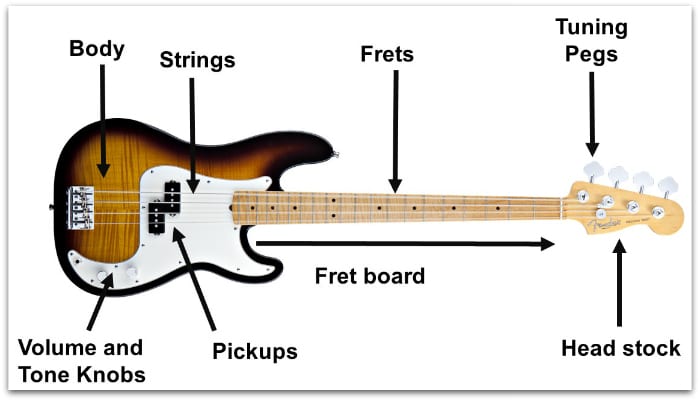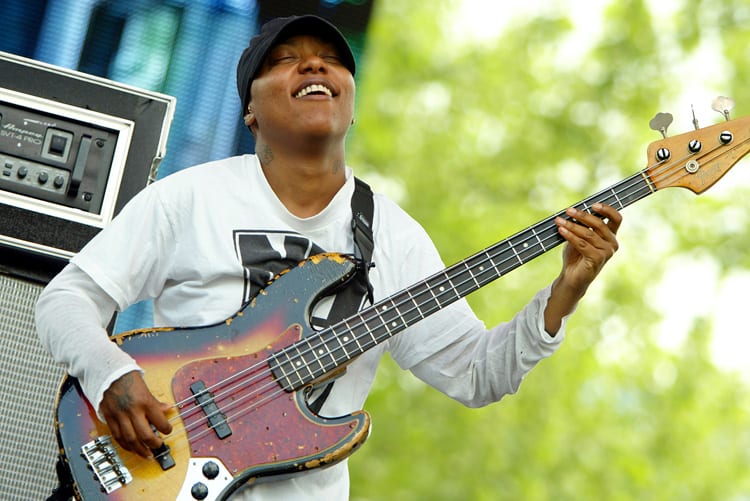Looking for bass lessons? Then you’re in the right place, we’re going to talk you through 6 essential tips that you need to know if you want to play bass guitar.
In this free bass lesson you will learn:
- The no1 secret to becoming a bass master.
- 3 root note hacks which will enhance your playing.
- 2 must-know lessons that will expand your fretboard knowledge.
- 2 essential tips that will take your bass playing to the next level.
Over 250,000 guitar-learners get our world-class guitar tips & tutorials sent straight to their inbox: Click here to join them
What is a bass guitar?
Often, the bass guitar gets a bit of a bad rep from guitarists. However, bass guitarists hold the band together.
Without a bass guitar, a band would be nothing. It’s the bass guitar that allows the band to sound HUGE.
Check out 40 of the greatest bassists of all time, in this article by NME: 40 of The Greatest Bassists of All Time | NME
What’s The Difference Between Bass Guitar and Normal Guitar?
A bass guitar is quite different to a normal guitar. A bass guitar has 4 strings, where as an electric guitar has 6 strings.
An electric guitar is tuned E, A, D, G, B, E.
A Bass guitar only uses the strings E A D G, however these strings are tuned on octave below the guitar.
What Does A Bass Guitar Do?
A bass guitar often plays bass lines which support the rest of the band.
As the strings on a bass are tuned down an octave, it provides an extra bit of low end thud which just isn’t provided by an electric guitar.
Here’s a great example of rock band royal blood taking bass guitar to it’s limits. Who needs guitars anyway?
Before we look into some bass lessons. Let’s learn about the bass guitars anatomy.
Download our lead guitar cheat-sheet to make things easier
It's hard to understand which scales work with which keys.
So we created a cheat-sheet! A key and scale-finder that you can use again and again.

Get your personalised guitar-learning plan 🎸
Get a custom guitar-learning plan here: Click here for GuitarMetrics™
World-Class Guitar Courses 🌎
Learn from the world's best guitar educators: Click here for our guitar courses
Bass Lessons – The Anatomy of A Bass Guitar
The bass is quite similar to a guitar however there are a few subtle changes:
- The strings.
There’s only 4 of them. These are tuned E A D G.
- The fretboard.
This is similar to the guitar, but the fret board and neck are longer.
- The frets.
Exactly the same as a guitar. These are the pieces of metal on the fret board.
- Tuning pegs.
These are used to tune the bass.
- The headstock.
This is where the tuning pegs are held.
- The bridge.
This is where the strings are held in place.
- The body.
The core part of the bass guitar.
- Pickups.
These amplify the sound of the bass.
- Volume and tone knobs.
Volume knobs controls how loud your bass is, the tone control how bright or dark you want your bass to be.
Want free guitar tips and video lessons delivered to your inbox?
Join over 250,000 guitar learners and subscribe to our guitar-tips-by-email service. (It's free.)
We'll send you a series of lessons that will move you to the next level of your guitar journey.
Learn how everything fits together quickly, easily and effectively. We share ninja tips (for instant fun!) but also timeless fundamentals that will deepen your understanding.
Our Guitar Courses
To become a better guitarist click here to see our guitar courses
Get your personalised guitar-learning plan 🎸
Want us to make a guitar-learning plan that is customised to you? Click here for GuitarMetrics™
Bass lessons – How To Play Bass Guitar
One of the main roles of a bass player is to play root notes.
It’s important that we have a good grasp of what a root note is as you’ll be spending most of your bass playing life, playing root notes.
Bass Lessons – What Is A Root Note?
The root note is the FIRST note in the chord. It’s important to understand what this is, as this holds the band together.
Bass players, don’t usually play chords, they play single notes.
Guitarists are more likely to play chords (ie. a group of notes which work in harmony together.)
If a guitarist is playing a chord, the bass player usually plays a root note of that chord.
For example, if a guitarist is playing a G chord, the bass player will play a G root note underneath this.
Why Is This Important To Know?
The root notes are what hold together a chord, there’s something extremely powerful about a bass playing a root note which is an octave below the original chord.
Bass Lessons – Learning The Root Notes
On a bass guitar, it’s important to know all of the root notes on the E string. If you can play and understand where these root notes are, you can accompany any guitarist in a band.
Here are all the root notes on the low E string:
What About Other Notes?
Here are all of notes on a bass guitar:
You don’t need to know EVERY note on a bass guitar. For the first six months of your bass journey, just focus on the low E string.
How Do I Use This?
Now you can see what all the root notes are, let’s see how we can use this practically.
Let’s say you’re playing with a guitarist, they’re playing the chords G – C.
If you were going to accompany them on the bass, you would play the notes.
- G on the 3rd fret of the E string.
- C on the 8th fret of the E string.
You would play these notes, because they are ROOT notes of what the guitar is playing.
That would sound something like this:
Can you hear how this adds a low end thickness to the guitar? It sounds huge!
This also works for minor chords.
For example, if the chord progression was:
Em – Gm
You would play the following notes:
- A open low E string.
- 3rd fret of the low E string.
Bass Lessons – Learning Arpeggios
Another way you can expand your root note is to use major and minor arpeggios.
This can add an interesting colour to your bass playing!
What’s An Arpeggio?
An arpeggio is simply a chord which is broken up into individual notes. When we play a chord, we often play a group of notes together.
Where as when we play an arpeggio, we play the same notes individually.
So for example, here’s what a chord sounds like on a normal guitar:
Here’s what it sounds like when we arpeggiate it:
I’ve used an acoustic guitar for this example, because if we did this on a bass it would sound a little muddy.
Bass Lessons – Learning Arpeggios
In music, two of the most common chord types are major and minor chords.
So if we want to accompany these on bass, it makes sense to learn the major and minor arpeggios of these chords.
Bass Lessons – The Major Arpeggio
This arpeggio works exclusively over the major chord.
We’re going to learn this arpeggio in the key of A.
If you wanted to use this arpeggio, you could use it over an A major chord. Just pick any of the notes within an arpeggio.
Bass Lessons – The Minor Arpeggio
This arpeggio works exclusively over a minor chord.
We’re going to learn this arpeggio in the key of A. Therefore this is A minor arpeggio.
If you wanted to use this arpeggio, you could use it over an A minor chord. Just pick ANY of these notes.
Get our best guitar tips & videos
Where should we send it?
Get our best guitar tips & videos












